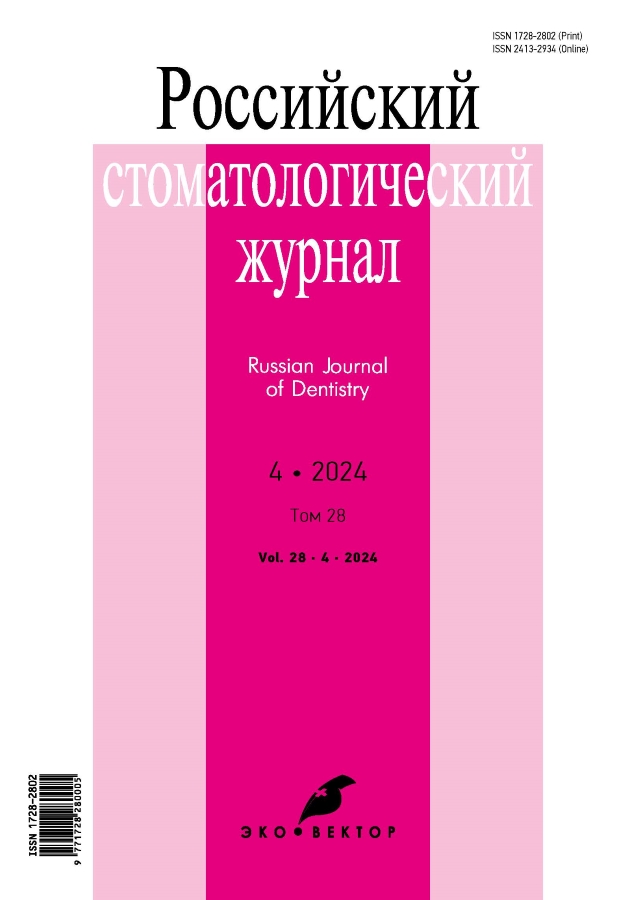Factor analysis for assessing the etiopathogenesis of facial boils in military personnel
- 作者: Borodulina I.I.1, Petrova T.V.1, Chernegov V.V.1
-
隶属关系:
- Kirov Military Medical Academy
- 期: 卷 28, 编号 4 (2024)
- 页面: 375-382
- 栏目: Clinical Investigation
- ##submission.dateSubmitted##: 15.01.2024
- ##submission.dateAccepted##: 16.04.2024
- ##submission.datePublished##: 14.11.2024
- URL: https://rjdentistry.com/1728-2802/article/view/625680
- DOI: https://doi.org/10.17816/dent625680
- ID: 625680
如何引用文章
详细
Background: Boils are the most prevalent non-odontogenic inflammatory condition of the head and neck. The treatment of skin and subcutaneous tissue inflammations in the Russian Armed Forces (RAF) is a pressing issue. We were unable to find any data on the etiopathogenesis of facial boils in otherwise healthy RAF members, as well as the factors that contribute to the development of this condition.
Aim: To examine the causes of facial boils in military personnel, the factors that contribute to their development, and the association between them using factor analysis.
Materials and Methods: Between 2019 and 2021, 53 patients aged 18 to 25 years were examined and treated for abscess-forming face boils. Of these, 38 (72%) were conscripts and 15 (28%) were contract servicemen. At admission, clinical examinations (complaints, history taking, status localis, facial skin type and status) and laboratory tests (complete blood count, blood chemistry, immunoassay, and bacterial tests, including the composition and antibiotic sensitivity of microflora) were performed. The control group included 30 otherwise healthy individuals aged 18 to 25 years. A mathematical model for predicting maxillofacial boil development in military personnel was generated using binomial regression analysis (logistic regression). The following variables were considered: age, length of service, season of disease development, serum glucose level, lymphocyte count, white blood cell count, CD3+, CD4+, CD8+, IgA, IgG, IgM, immunosuppressive regulatory T cells (CD4+CD25brightCD45+; % of all T helper cells), skin type, and microbial composition of maxillofacial skin.
Results: The mathematical model revealed that oily skin in combination with specific blood lymphocyte (20.30±1.03%) and IgG parameters (10.15±0.70%) increases the risk of maxillofacial boils in military personnel.
Conclusion: The study revealed the cumulative effect of general and local factors on the development and progression of facial boils in military personnel, allowing for more accurate prevention and treatment strategies.
全文:
作者简介
Irina Borodulina
Kirov Military Medical Academy
Email: borodulina59@mail.ru
ORCID iD: 0000-0003-1036-6455
SPIN 代码: 3067-6777
MD, Dr. Sci (Medicine), Professor
俄罗斯联邦, St. PetersburgTatiana Petrova
Kirov Military Medical Academy
编辑信件的主要联系方式.
Email: tanya-petrova-1995@yandex.ru
ORCID iD: 0000-0001-9079-1149
SPIN 代码: 1406-9138
MD, Cand. Sci. (Medicine)
PHD, lecturer at the Department of Maxillofacial Surgery and Surgical Dentistry of the V.Med. CM. Kirov 俄罗斯联邦, St. Petersburg
Valentin Chernegov
Kirov Military Medical Academy
Email: vchernegov@mail.ru
ORCID iD: 0000-0001-9191-4016
SPIN 代码: 9301-4984
MD, Cand. Sci. (Medicine), Associate Professor
俄罗斯联邦, St. Petersburg参考
- Kulakov AA, Braylovskaya TB, Grebnev GA, et al. Comparative characteristics of the incidence of boils in the maxillofacial area in military personnel and civilians. Dentistry. 2022;101(3):31–37. doi: 10.17116/stomat202210103131
- Imbryakov KV, Nikolsky VYu. Comparison of morbidity and treatment tactics for patients with boils and facial carbuncles in the Samara and Kirov regions. Russian Journal of Dentistry. 2013;5:27–29. EDN: RVOYKX
- Solovyov MM, Bolshakov OP, Galetsky DV. Purulent-inflammatory diseases of the head and neck: etiology, pathogenesis, clinical picture, treatment. Moscow: Smart Doctor; 2016. 192 p. (In Russ.)
- Fayzullina GA, Mirsaeva FZ. Etiopathogenetic features of a boil in the maxillofacial region. Medical Bulletin of the North Caucasus. 2018;11(13):38–41. doi: 10.14300/mnnc.2018.13011
- Petrova TV, Borodulina II, Grebnev GA, et al. Analysis of the incidence of facial boils in military personnel. News of the Russian Military Medical Academy. 2021;40:121–124. EDN: ZVHTGQ
- Evdokimov VI, Sivaschenko PP, Grigoriev SG. Morbidity rates for contract servicemen of the Armed Forces of the Russian Federation (2013–2016). St. Petersburg: Polytechnics-print; 2018. 80 p. (In Russ.) EDN: TUXSHB
- Grigoriev SG, Evdokimov VI, Ivanov VV, et al. Medical and statistical characteristics of the incidence of conscripted military personnel of the Armed Forces of the Russian Federation (2007–2016). Military Medical Journal. 2017;10(338):4–14. (In Russ.) EDN: VZNYJN
- Noble WC. Skin bacteriology and the role of Staphylococcus aureus in infection. Br J Dermatol. 1998;139(53):9–12. doi: 10.1046/j.1365-2133.1998.1390s3009.x
- Artiz O, Sinai M, Solomon M, Schwartz E. Recurrent furunculosis in returning travelers: newly defined entity. J Trav Med. 2015;22(1):21–25. doi: 10.1111/jtm.12151
- Petrova TV, Borodulina II, Tegza NV. Etiopathogenetic aspects of boils in the maxillofacial region (literature review). Modern Science: current issues of theory and practice. Series: natural and technical sciences. 2021;12:209–216. doi: 10.37882/2223-2966.2021.12.25
- Ibler KS, Kromann CB. Recurrent furunculosis — challenges and management: a review. Clin Cosmet Investig Dermatol. 2014;7:59–64. doi: 10.2147/CCID.S35302
- Fleryanovich MS, Pokhodenko-Chudakova IO. Lipid spectrum of patients with boils of the maxillofacial area at the present stage. Medical Journal. 2019;2:124–128. EDN: NHWOAX
- Kalinina NM. Immunity disorders in recurrent furunculosis. Cytokines and Inflammation. 2003;2(3):41–44. EDN: HRRJRR
- Kasenova NS. Etiopathogenesis and frequency of development of boils and carbuncles of the maxillofacial region: (literature review). Healthcare of Kyrgyzstan. 2018;11(13):38–41. EDN: ZVLCUF
- Vyazitsky PO, Dyakonov MM, Endaltsev BV. Adaptation of a young soldier to the conditions of military service and prevention of maladaptive disorders. Moscow: USSR Ministry of Defense; 1990. 28 p.
- Paklin RV. Indicators of adaptation of conscript soldiers to new living conditions. Perm Medical Journal. 2010;27(1):113–117. EDN: NCKMUH
补充文件








